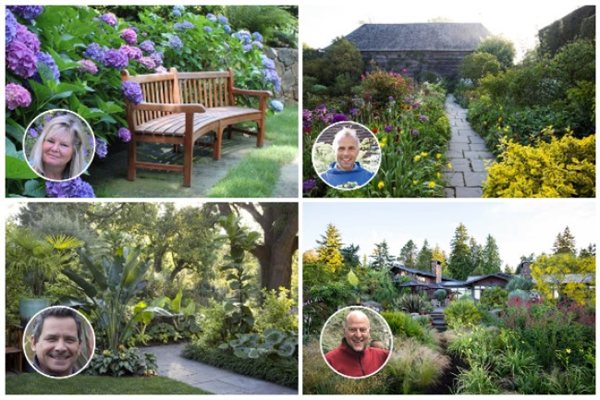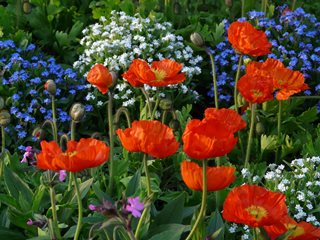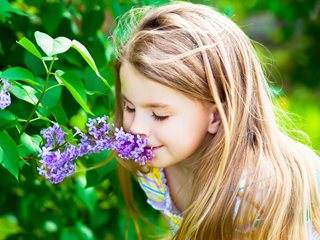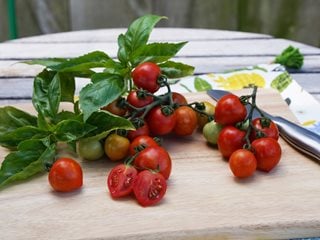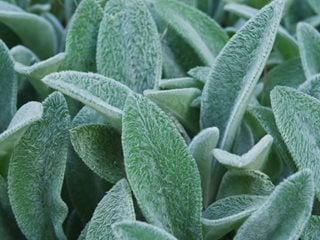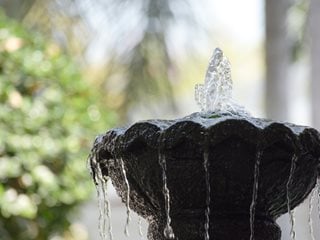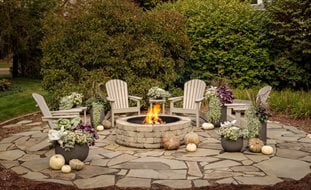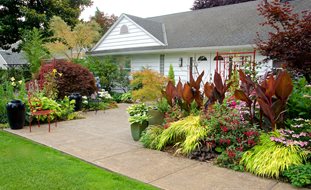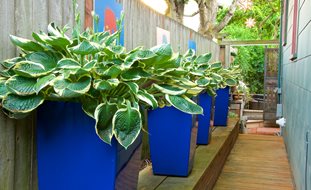Engaging Your Senses in the Garden
How to design a sensory garden to appeal to all five of your senses Published 6/3/2022We all know that there are plants that taste good, plants that smell good, plants that look good…and plants that have all these qualities, plus more.
The way plants engage the senses creates a satisfying experience in the garden, and it’s also a great way to guide our plant selections—and even where we place plants. Here are ideas for making your outdoor space an area that enlivens each of your five senses, creating an even stronger connection between you and your garden.
SIGHT
At first, it seems obvious to consider sight when planting and designing your garden. After all, no one goes to a nursery with the intent to come home with plants that they don’t like looking at. Yet it’s common for gardeners to be overwhelmed by plant choices and never totally sure how to put it all together to make their space visually appealing. Whether you have a balcony or larger area to work with, here are some ways to make your garden a spot you love to look at.
- Be strategic about color. There’s more to it than just choosing plants with bloom colors you like. A little knowledge about using color in the garden can go a long way.
- Opt for low maintenance. Having plants that don’t need a ton of attention reduces the stress associated with looking at your garden and building your to-do list in your head. (Your back will thank you, too.) Get ideas from this list of 21 low-maintenance plants.
- Think beyond plants. A garden’s beauty comes from much more than just its plants. The creatures that visit increase the beauty of a garden tenfold. Love seeing butterflies? Select plants that will attract them.
- Add color from foliage. Rather than focusing all your attention on blooms, experiment with plants with colorful foliage as another way to get a variety of interesting colors.
SMELL
Choosing plants that smell good is a given, but where’s the best place to put them? Make the most of your good-smelling plants by putting them in spots where you’ll get to enjoy their scent often. Here are some placement ideas:
- Put pots on your front porch. Enjoy plants that do well in containers and provide a pleasing scent. Sweet alyssum, phlox, and geranium are three that fit the bill. (Note: Geraniums are known to be toxic to children and pets, so make sure they are out of reach.)
- Trellised along a wall next to an oft-opened window. Climbing plants such as lilac and honeysuckle look great scaling a wall-and when growing next to a window, they perform double-duty. (Note: Some varieties of honeysuckle can be toxic to children and pets, so choose a variety that’s right for your outdoor space.)
- Along a walkway. As you walk along pathways that meander through your front or backyard, scented plants along the way add to the experience. Easy-care lavender is a great choice for this purpose.
- Include hanging planters on your porch or back patio. Hanging a few planters from your porch/patio cover or pergola can work wonders to enhance your backyard space. Trailing verbena is just one example of a flowering plant that looks beautiful in a hanging planter-it smells good, too.
TASTE
It’s been said many times, but that’s because it’s true: food always tastes better when it’s homegrown! Here are some things to consider when choosing what you’ll grow.
- Choose unique crops. Many of us are creatures of habit, growing the same food every year (hello, zucchini!). While there’s not anything wrong with doing what works, it’s also fun to mix things up. Trying something new that you can munch on in the garden or use as inspiration to try a new recipe is an enjoyable way to enhance the farm-to-table experience.
- Consider a thematic edible garden. In the spirit of square-foot gardening, you can designate a patch of garden bed to growing crops that fit into a specific theme such as a pizza garden (basil, tomatoes, garlic, etc.), tea garden (different types of mint, chamomile, lavender, etc.), and more.
- Don’t forget the flowers. Plants with edible flowers—nasturtiums, pansies, and marigolds to name a few—are a culinary delight, and they’re fun to nibble as you wander in the garden.
- Think about the kiddos. If you have kids that frequent your garden, help them expand their palettes and encourage their love of gardening by giving them some space to grow and taste food.
If you’re new to edible gardening, here’s a simple overview of how to start a vegetable garden.
TOUCH
There’s something soothing about rubbing a fallen fresh rose petal between your fingers or discovering that a leaf feels almost velvety to the touch. While there are some plants you don’t necessarily want to be touching all the time—whether it’s because they’re too delicate or too pokey—it is nice to include some that can engage your sense of touch. Here are some plants you might like to include in your garden:
- Lamb’s ear. If you haven’t had the chance to feel the leaves of this easy-care plant, get to your nearest nursery ASAP! Bonus: the velvety-soft leaves of lamb's ear also serve to deter deer.
- Chenille plant. With flowers that are often described as “yarn,” this tropical plant has an appearance that compels you to reach out and touch it. Since it’s hardy to zones 10-11, you may want to either keep it as a houseplant or put it in a container so you can move it to a protected area during winter.
- Moss. Often considered ancient plants you see only in wild spaces, moss is a great lawn alternative in climates where the climate allows—and the experience of walking on a moss “lawn” is otherworldly. (Have you ever seen J. Paul Moore’s moss lawn?) If this is something you decide to pursue, you’ll want to figure out what species is right for your area. If you’re not in the right climate for an entire moss lawn, consider a small patch of moss in a shady spot that gets regular water.
- Grasses. There’s something about grasses that make us want to reach out and touch them—a quality that makes them a great option for planting along walkways or next to seating areas. We recommend varieties such as Hakonechloa macra ‘Aureola’ (Japanese forest grass), or those in the Proven Winners Graceful Grasses® series such as ‘Fireworks’, Purple Fountain Grass, or King Tut®.
SOUND
Hopefully part of your gardening routine includes having a seat and taking in all the fruits of your hard work. One way to enhance that experience is by creating an environment that’s pleasing to the ears.
- Incorporate plants that sway. On a quiet day, the slightest breeze can activate the delightful sounds of grasses swaying. Here are some ornamental grass varieties we love.
- Include water features. A water feature—whether its something simple such as a small fountain or something more involved such as a water rill—not only adds calming sounds but can also serve to drown out unwanted noises from neighbors or nearby traffic. See more water feature ideas.
- Add sound barriers. Many people have backyards or balconies that are close to neighbors. Finding ways to create sound barriers can make your space feel more private. You can do this in many ways such as planting hedges along property lines, including trailing hanging plants, or adding barrier walls that absorb sound.
- Bring in the birds. If you love the sounds of birds chirping and flitting about, add elements that will draw them into your garden such as birdfeeders, plants with berries, and bird baths. Here are more ideas for attracting wildlife.
RELATED: How to Create a Peaceful Garden
